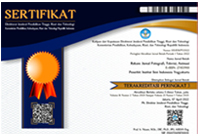Abstract
Fantasy films were born from the development of fiction films that have shown existence since the beginning of its history. Fantasy films have their own charm because they can penetrate time and space compared to other genres. Fiction films develop from their creators both in terms of story and cinematography because fiction films are at the center of the poles: real and abstract. Its greatest strength lies in its ability to integrate and combine with other genres without exception and can be broadly developed unlimitedly. That is because fantasy films contain elements with different characteristics from other films where if a fantasy film has one element in the making of the film then it has been said to be a fantasy film. The elements or components that are seen are derived from the narrative and cinematic elements of filmmaking which contain ideas of stories, characters, and settings in a film. These three elements are the forming components of fantasy films that are fictitious and imaginative. The idea of the story is not based on an imaginary reality, that is a fiction that makes no sense. In the case of fantasy films, filmmakers will compete to develop and present ideas that have not been thought of before, so the audience seems to be carried away in a new world outside of real life. Character characters in fantasy films are the imagination of creators in fictitious forms, such as: animal characters, extraterrestrials, monsters, robots, and non-physical characters such as ghosts, spirits and holograms. While the background elements in fantasy films have a character setting place and time imaginative events are unique in unknown times or dimensions, can be past, present, and future with the centuries formed by the creators.
Keywords
Fantasy, Fictitious, Imaginative.
References
DAFTAR PUSTAKA
Ali, Matius. 2010. Psikologi Film, Membaca Film Lewat Psikoanalisis Lacan-Zizek. Jakarta: Fakultas Film dan Televisi Institut Kesenian Jakarta (FFTV IKJ)
Bordwell, D., & Thompson, K. (1950). Film Art, An Introduction (8th ed.). New York: The McGraw-Hil
Eisenstein, S. (1957). Film Form and The Film Sense. USA: Meredian Books Harymawan. “Dramaturgi”. Bandung: Remaja Rosda Karya. 1988
Ismail, Umar. “Mengupas Film”. Jakarta: PT. Pustaka Sinar Harapan. 1986
Luthfi, Alexandri, “Pendidikan Seni Film Dan Televisi Sebagai Penggerak Industri Ekonomi Kreatif”. Jurnal REKAM, Vol. 13 No. 2 - Oktober 2017. Yogyakarta: ADSMRI dan FSMR ISI Yogyakarta
Nur Rohma, Naafi. “Estetika Formalis Film Pohon Penghujan Sutradara Andra Fembriarto”. Jurnal REKAM, Vol. 13 No. 1 – April 2017. Yogyakarta: ADSMRI dan FSMR ISI Yogyakarta
Pratista, Himawan. “Memahami Film”. Yogyakarta: Homerian Ed 1, 2008
Pratista, Himawan. “Memahami Film”. Yogyakarta: Homerian Ed 2, 2017
Stokes, Jane. “How To Do Media and Cultural Studies”. Yogyakarta:
Bentang, 2007
Suwardi, Harun. 2006. Kritik Sosial dalam Film Komedi. Jakarta: FFTV-IKJ Press.




